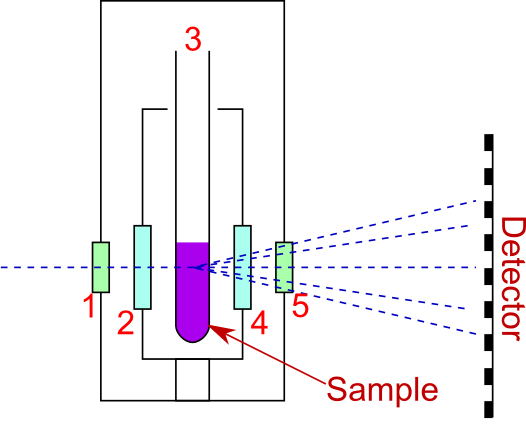3.3.3.2. NXcontainer¶
Status:
contributed definition, extends NXobject, version 1.0
Description:
State of a container holding the sample under investigation.
A container is any object in the beam path which absorbs the beam and whose contribution to the overall attenuation/scattering needs to be determined to process the experimental data. Examples of containers include glass capillary tubes, vanadium cans, windows in furnaces or diamonds in a Diamond Anvil Cell. The following figures show a complex example of a container:

A hypothetical capillary furnace. The beam passes from left to right (blue dashes), passing through window 1, then window 2, before passing through the downstream wall of the capillary. It is then scattered by the sample with scattered beams passing through the upstream wall of the capillary, then windows 4 and 5. As part of the corrections for a PDF experiment it is necessary to subtract the PDF of the empty container (i.e. each of the windows and the capillary). To calculate the PDF of the empty container it is necessary to have the measured scattering data and to know the nature (e.g. density, elemental composition, etc.) of the portion of the container which the beam passed through.

A complete description of the shapes of the container elements with their orientation relative to the beam and also information on whether they are upstream or downstream of the sample is also therefore important. For example, although the windows 2 and 4 have the same shape, the path taken through them by the beam is very different and this needs to be modelled. Furthermore, it is not inconceivable that windows might move during an experiment and thus the changes to the beampath would need to be accounted for.
This class encodes the position of the container with respect to the sample and allows the calculation of the beampath through the container. It also includes sufficient data to model beam absorption of the container and a link to a dataset containing a measurement of the container with nothing inside, to allow data corrections (at a specific beam energy/measurement time) to be made.
Symbols:
No symbol table
- Groups cited:
- NXbeam, NXshape, NXtransformations
Structure:
name: NX_CHAR
Descriptive name of container.description: NX_CHAR
Verbose description of container and how it fits into the wider experimental set up.chemical_formula: NX_CHAR
Chemical composition of the material the container is made from. Specified using CIF conventions. Abbreviated version of CIF standard:
- Only recognized element symbols may be used.
- Each element symbol is followed by a ‘count’ number. A count of ‘1’ may be omitted.
- A space or parenthesis must separate each cluster of (element symbol + count).
- Where a group of elements is enclosed in parentheses, the multiplier for the group must follow the closing parentheses. That is, all element and group multipliers are assumed to be printed as subscripted numbers.
- Unless the elements are ordered in a manner that corresponds to their chemical structure, the order of the elements within any group or moiety depends on whether or not carbon is present.
- If carbon is present, the order should be:
- C, then H, then the other elements in alphabetical order of their symbol.
- If carbon is not present, the elements are listed purely in alphabetic order of their symbol.
- This is the Hill system used by Chemical Abstracts.
density[n_comp]: NX_FLOAT {units=NX_MASS_DENSITY}
Density of the material the container is made from.packing_fraction[n_comp]: NX_FLOAT {units=NX_UNITLESS}
Fraction of the volume of the container occupied by the material forming the container.relative_molecular_mass[n_comp]: NX_FLOAT {units=NX_MASS}
Relative molecular mass of container.beam: NXbeam
Details of beam incident on container, including the position relative to the sample (to determine whether the container is upstream or downstream of the sample).shape: NXshape
Shape of the container. In combination with orientation this should allow the beampath through the container to be modelled to allow the adsorption to be calculated.orientation: NXtransformations
The angle the container makes to the beam and how it may change during the experiment.In combination with shape this should allow the beampath through the container to be modelled to allow the adsorption of the container to be calculated.reference_measurement –> /NXentry
A link to a full data collection which contains the actual measured data for this container within the experimental set up (with no sample or inner container(s)). This data set will also include the wavelength/energy, measurement time and intensity for which these data are valid.
